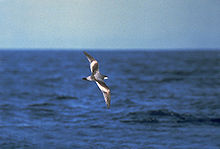Buller's shearwater
This article includes a list of general references, but it lacks sufficient corresponding inline citations. (January 2009) |
| Buller's shearwater | |
|---|---|

| |
| Scientific classification | |
| Domain: | Eukaryota |
| Kingdom: | Animalia |
| Phylum: | Chordata |
| Class: | Aves |
| Order: | Procellariiformes |
| Family: | Procellariidae |
| Genus: | Ardenna |
| Species: | A. bulleri
|
| Binomial name | |
| Ardenna bulleri (Salvin, 1888)
| |

| |
Buller's shearwater (Ardenna bulleri) is a
Description

Adults
The underside is bright white; on the head the upperside's grey extends town to eye height and the white cheeks may shine up conspicuously, as in the smaller shearwaters of
Compared to other shearwaters, the species is unusually easy to identify at sea by its combination of considerable size and the distinctive, M-shaped banding pattern on its upperside while flying, uniquely among its genus and more akin to some gadfly petrels (Pterodroma), the prions (Pachyptila) and their relative, the blue petrel (Halobaena caerulea). These are all much smaller birds, perhaps two-thirds in length and wingspan and less than half in bulk of Buller's shearwater.[3]
Range and ecology
This species is
Buller's shearwater feeds mainly on
It is a
The breeding season starts in October and lasts for almost half a year. A single egg is incubated for about 51 days, with the parents changing between incubation and feeding every 4 days or so. Time to
In the past, it was heavily used as a food source by the
See also
- Seabird colony
References
Further reading
- Austin, Jeremy J. (1996): Molecular Phylogenetics of Puffinus Shearwaters: Preliminary Evidence from Mitochondrial Cytochrome b Gene Sequences. (HTML abstract)
- Austin, Jeremy J.; Bretagnolle, Vincent & Pasquet, Eric (2004): A global molecular phylogeny of the small Puffinus shearwaters and implications for systematics of the Little-Audubon's Shearwater complex. DOI: 10.1642/0004-8038(2004)121[0847:AGMPOT]2.0.CO;2 HTML abstract HTML fulltext without images
- Carboneras, Carles (1992): 58. Buller's Shearwater. In: del Hoyo, Josep; Elliott, Andrew & Sargatal, Jordi (eds.): ISBN 84-87334-10-5
- Penhallurick, John & Wink, Michael (2004): Analysis of the taxonomy and nomenclature of the Procellariiformes based on complete nucleotide sequences of the mitochondrial cytochrome b gene. doi:10.1071/MU01060(HTML abstract)
- Wiles, Gary J.; Johnson, Nathan C.; de Cruz, Justine B.; Dutson, Guy; Camacho, Vicente A.; Kepler, Angela Kay; Vice, Daniel S.; Garrett, Kimball L.; Kessler, Curt C. & Pratt, H. Douglas (2004): New and Noteworthy Bird Records for Micronesia, 1986–2003. Micronesica 37(1): 69–96. HTML abstract
Further reading
- Harrison, Peter (1983): Seabirds: An Identification Guide. Croom Helm, Beckenham. ISBN 0-7099-1207-2
- ISBN 0-7922-6877-6

